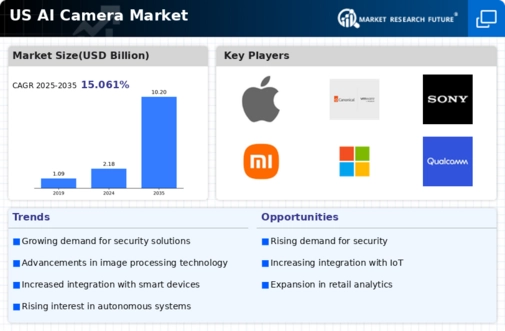The US AI Camera Market has experienced significant growth in recent years, increasingly driven by advancements in artificial intelligence technology that enhance image processing, user experience, and overall functionality. As this market evolves, competition intensifies among key players, focusing on innovating capabilities, integrating AI features, and improving product offerings to meet the dynamic needs of consumers. Companies are investing in R&D to develop smarter camera solutions that leverage machine learning algorithms for features such as facial recognition, scene detection, and enhanced video capabilities.
The rising demand for sophisticated photography solutions among both professional and amateur photographers is fostering a robust competitive landscape, leading to strategic partnerships, collaborations, and the introduction of cutting-edge products that align with consumer expectations and technological trends.In the realm of the US AI Camera Market, Apple has distinguished itself with a strong commitment to integrating advanced AI capabilities into its ecosystem.
Apple's approach centers around its seamless integration of software and hardware, particularly within its flagship products such as the iPhone and iPad, which feature sophisticated camera systems powered by in-house AI technology. This allows Apple to offer superior image processing capabilities, enabling features like Night mode, Smart HDR, and computational photography enhancements. The company's significant presence in both the consumer electronics and photography markets is strengthened by its loyal customer base, innovative marketing strategies, and a reputation for high-quality, user-friendly products that cater to both casual users and photography enthusiasts.
Apple's focus on delivering regular software updates also enhances its camera features over time, ensuring users have access to the latest enhancements and functionalities.Canon maintains a notable presence in the US AI Camera Market, particularly in the realm of consumer and professional photography. The company's range includes high-quality DSLRs, mirrorless cameras, and compact models, catering to various segments of the market. Canon's strength lies in its long-standing reputation for optical excellence and reliability, coupled with a diverse product portfolio that incorporates AI-driven features to improve autofocus capabilities and image quality.
Canon has made strategic collaborations to enhance its technology and expand its offerings, pursuing innovation in AI-driven photography solutions. Additionally, the company's commitment to research and development, including efforts to integrate software that leverages deep learning for improved performance, has positioned it favorably among competitors. Canon has undergone mergers and acquisitions, helping to bolster its technological capabilities and expand its market share within the US, setting it apart as a versatile and trusted brand among both professionals and consumers.
























